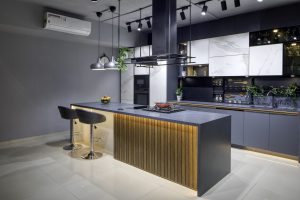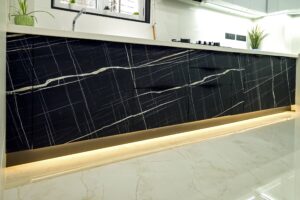Introduction
Designing cabinets and shelves for your kitchen can be both exciting and overwhelming. It’s not just about making your kitchen look pretty, but also ensuring it functions effectively. Whether you’re renovating or building a new kitchen, having the right storage is key to a functional and stylish space. The kitchen is the heart of the home and one of the most important elements of any kitchen is its storage system. Whether you are dealing with a small or large kitchen, having well-designed cabinets and shelves can make all the difference. Not only do they provide essential storage space, but they also contribute to the overall aesthetic and functionality of your kitchen. This blog will walk you through everything you need to know about designing kitchen cabinets and shelves that are both practical and stylish.
Why do Kitchen Cabinets and Shelves Matter?
Kitchen cabinets and shelves are more than just storage solutions; they are the backbone of your kitchen’s organization. They help keep your kitchen clutter-free, allow easy access to your kitchen tools, and can even influence how you move and work in the space. Poorly designed cabinets or shelves can result in wasted space, inefficiency and a less enjoyable cooking experience.
Assessing Your Kitchen’s Needs
Evaluate Your Cooking Habits:
Before you start designing, consider how you use your kitchen. Do you cook large meals frequently or do you prefer quick and easy dishes? Your cooking habits will determine the kind of storage you need. For instance, if you love baking, you might need more storage for specialized equipment like mixers and pans.
Consider Your Storage Requirements:
Think about what you need to store. Do you have a large collection of spices? Are you looking for a place to store bulky appliances? Understanding your storage needs will help you design a kitchen that works for you, rather than against you.
Types of Kitchen Cabinets
![]()

Base Cabinets:

Base cabinets are the foundation of your kitchen’s storage. These are the cabinets that sit on the floor and support your countertops. They often include drawers and doors to store items like pots, pans and utensils.
Wall Cabinets:
Wall cabinets are mounted on the wall above your countertops. These are great for storing items you need regularly, like dishes and glasses. Make sure to install them at a height that is easy to reach.
Tall Cabinets:
Tall cabinets are ideal for storing larger items, such as brooms or even acting as a pantry. These cabinets extend from the floor to near the ceiling, providing extra storage for items you don’t use every day.
Types of Kitchen Shelves
Open Shelves:
Open shelves are a popular choice in modern kitchens. They provide easy access to everyday items and add an airy feel to the room. However, they require regular cleaning since items are exposed to dust and grease.
Floating Shelves:
Floating shelves are sleek and minimalist, with no visible brackets. They are ideal for displaying decorative items, cookbooks or small kitchen gadgets.
Pull-Out Shelves:
Pull-out shelves are a space-saving solution that allows you to store items deep inside a cabinet without losing access. They are perfect for spices, canned goods or cleaning supplies.
Designing for Functionality
Maximize Storage Space:
When designing your cabinets and shelves, consider ways to maximize storage. Use corner cabinets, add pull-out trays or install adjustable shelving to make the most of every inch.
Creating Easy Access:
Make sure your most-used items are easy to reach. Keep heavy pots and pans in base cabinets and store everyday items at eye level.
The Importance of Layout
Work Triangle Considerations:
The kitchen work triangle – the space between the stove, refrigerator and sink – is an essential design principle. Your cabinets and shelves should not interfere with this workflow.
Balancing Aesthetics with Utility:
While it’s important for your kitchen to look good, it’s more important that it functions well. Find a balance between form and function to create a space you’ll love working in.
Cabinet and Shelf Styles
Modern:
Modern kitchen cabinets are sleek, with clean lines and minimal hardware. Open shelving often complements modern designs.
Rustic:
Rustic cabinets and shelves often feature natural wood finishes and a more traditional, cosy design.
Traditional:
Traditional kitchens typically feature more ornate cabinets with detailed hardware, often paired with closed shelves.
Incorporating Hardware and Finishes
Knobs and Pulls:
The type of hardware you choose can drastically change the look of your kitchen. Opt for knobs and pulls that complement the overall design.
Soft-Close Hinges:
Soft-close hinges are a must-have for modern kitchens, preventing cabinets from slamming shut.
Budgeting for Your Kitchen Cabinets and Shelves
Cost-Saving Tips:
Opt for stock cabinets and shelves rather than custom ones to save on costs. You can also choose affordable materials that still look high-end, like laminate or MDF.
Where to Splurge:
If your budget allows, splurge on items that will make a big difference, like soft-close hardware or high-quality countertops.
The Importance of Lighting
Under-Cabinet Lighting:
Under-cabinet lighting not only enhances the look of your kitchen but also makes it easier to see what you’re doing.
Accent Lighting:
Use accent lighting to highlight your open shelves or glass-fronted cabinets, adding a stylish touch to the space.
Conclusion
Designing cabinets and shelves for your kitchen is a rewarding process that requires thoughtful planning and attention to detail. By understanding your needs, choosing the right materials, and ensuring a balance between functionality and aesthetics, you can create a kitchen that is both beautiful and highly efficient.
